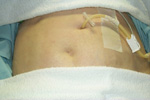Gastrostomy
What is a gastrostomy?
Critically ill or injured patients occasionally loose the ability to swallow for prolonged periods of time. A nasogastric tube (NG tube) or feeding tube provides a temporary way to give patients medications or nutrition. Because these tubes are inserted through the nose or mouth, they are usually not suitable for long periods of time. Instead, a tube inserted directly into the stomach through the skin overlying the stomach is usually required. The procedure is called a gastrostomy. The tube, called a gastrostomy tube (also G tube or stomach tube), may be inserted either surgically or by using an endoscope called a gastroscope.
How is a gastrostomy performed?
Surgical gastrostomy is performed in the operating room. The patient requires general anesthesia and the surgeon inserts the gastrostomy tube directly into the stomach after making an incision in the abdominal wall. The endoscopic technique involves the use of an gastroscope, a lighted flexible tube that is inserted through the mouth into the stomach. The gastroscope enables the doctor to see whatever is at the end of the flexible tube. The patient receives sedation plus a local anesthetic. The gastrostomy tube is inserted through the skin into the stomach while the doctor is looking into the stomach through the gastroscope. After the gastrostomy tube is secured, the nasogastric or feeding tube is removed.
How long is a gastrostomy tube used?
The gastrostomy tube may remain as long as the patient needs it. Under certain circumstances they can be used for years.
Does a gastrostomy hurt?
Not usually. There may be minor soreness at the incision following surgery, but with both methods of insertion medication can be used to reduce pain.
Are there any potential complications associated with a gastrostomy and G tube?
Complications associated with gastrostomy tube insertion are rare but include bleeding, infection, and improper tube placement.
Gastrostomy tube entering stomach through abdominal wall
